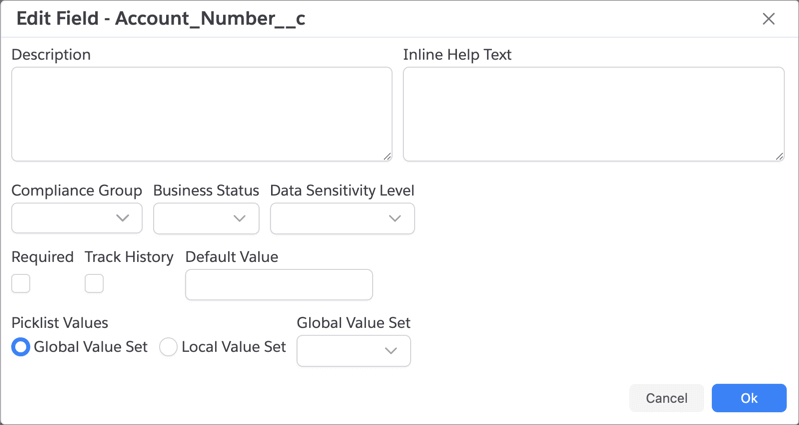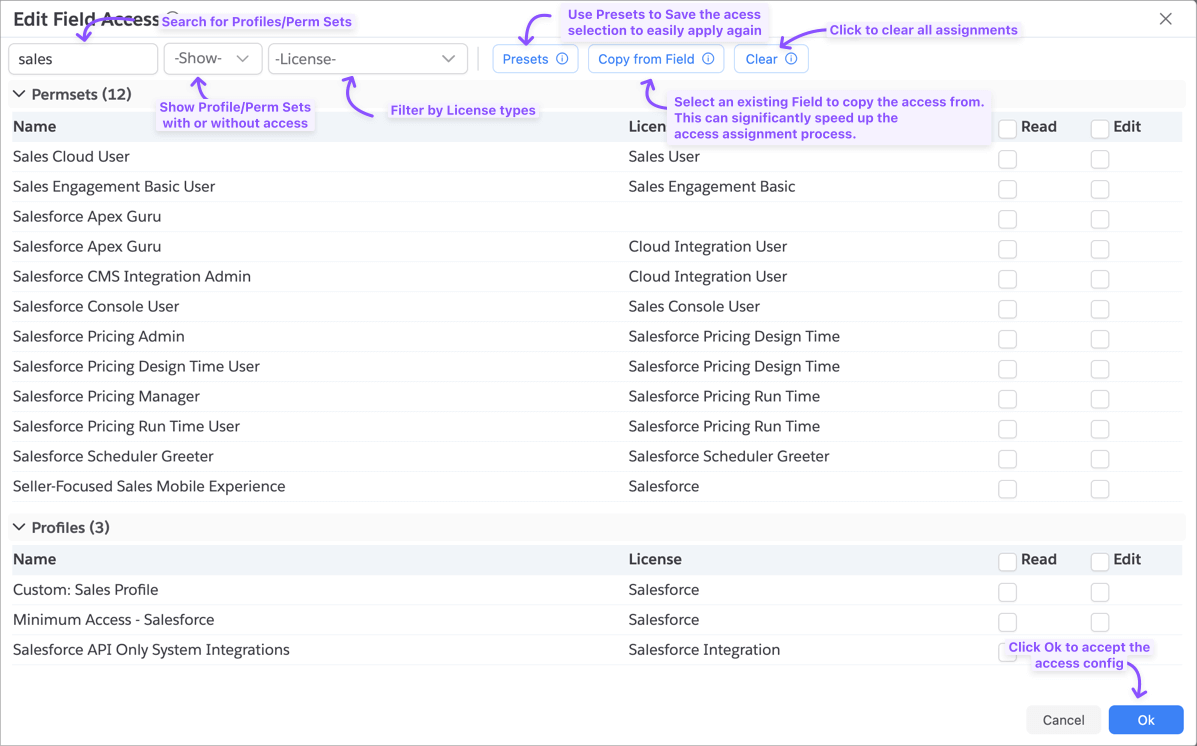Bulk Create Fields
The Create Fields feature allows you to efficiently create multiple custom fields in bulk with comprehensive configuration options. This powerful tool enables you to define field properties, configure access permissions for both profiles and permission sets, and speed up the field creation process with access presets to assign pre-configured access permissions with the click of a button.
Main Dialog
To access this feature, navigate to the Objects module, select an object, and click the Plus icon in the Fields tab toolbar. When you click this button, the Create Fields dialog will open as shown below.

Field Row Columns
Here are various columns in the main dialog.
| Column | Description |
|---|---|
| Actions | Shows various actions that acts on each Field row. |
| Type | Field data type (Text, Number, Currency, etc.) |
| Label | Display name for the field |
| Name | API name, auto-generated from label but you can change it too. |
| Description | Field description for documentation |
| Help Text | Inline help text shown to users |
| Properties | Type-specific configuration (length, decimals, etc.) |
Add More Rows
When the main dialog is open, it starts with a single field row. If you’re looking to create more fields, click on the
+ icon at the bottom-left of the Dialog. You can also enter a number in the input field to add multiple rows at once.
While creating fields, the app will ignore the rows that are missing the label/api name.
Field Naming Convention
App defaults to Underscore Case convention for field API names (For ex., Account_Number__c). You can change this to
Pascal Case (For ex., AccountNumber__c) in the setting. To access settings, click on the Gear icon in the
bottom-right of the main dialog.
More Options Dialog
Each row in the main interface allows you to specify only basic field properties. To configure additional properties for each field, click on the Pencil icon in the field you want to edit. This is especially useful for Picklist fields or if you want to configure field metadata like Owner, Compliance, etc.,

Field Access
When you click on the Field Access button, it shows you the below dialog where you can configure field permissions.

- The same field access configuration applies to all fields in the current batch.
- You can configure access for both Profiles and Permission Sets.
- By default, access is granted to the System Administrator profile.
Filtering Permset/Profiles List
App provides you three ways to filter the list to show only relevant profiles/permission sets.
- Search Box: Type in the search box to filter by name.
- Access Filter: Allows you to filter to show only those with access or without access.
- License Filter: Allows you to filter by Profile or Permission Set license type. If you select more than one, then it shows the list which matches any one of those.
If you specify more than one filter option, then the app applies all the filters to show you the results that matches all filter conditions.
Copy Access from Existing Field
Most of the time, you would want to configure access similar to an existing field in the object. To enable that
Copy from Field button allows you to just that saving you significant time and effort.
When you click on the button, the app shows you the below dialog with the list of fields. Select a field and click Ok
to copy access permissions from that field.
App doesn't remove the access which is already configured before you click on the button. If you want to have just that
field's access, Clear the access first and then copy the access.
Access Presets
Let's say you frequently create fields with similar access permissions. For example, a field for the legal team which
allows Read for all internal Profiles and Edit Legal profiles.
If you have a lot of Profiles/Permission Sets in your org, then configuring access every time can be tedious and error-prone in selecting just that list. This is where Access Presets come to the rescue.

Creating Presets
To create a Preset, first configure the access permissions as you want. Then click on the Presets -> New Preset button
and specify a name. Now the app will save the current access configuration against that name. You can create as many
presets as you want with different names.
Don't worry about saving access for Profiles/Permission Sets that might not be there in all orgs. When applying the Preset, the app will ignore the access for Profiles/Permission Sets not found in the current org.
Applying Presets
To apply a Preset, click on the Presets -> Load Preset button and select the Preset you want to apply. The app will
apply the access.
App will never remove the access which is already configured before you click on the button. If you want to have just
that Preset's access, Clear the access first and then load the Preset.
Updating a Preset
If you have a preset, and you want to update it with the current access configuration, click on the
Presets -> Update Preset button and select the Preset you want to update. If you’ve already loaded a preset, then
you can also click on the Presets -> Update Current Preset button to update the currently loaded preset.
Deleting a Preset
To delete a Preset, click on the Presets -> Delete Preset button and select the Preset you want to delete.
Clear Access
Clicking on the Clear button will remove all the access permissions configured so far. This is useful if you want to
reset and start over.
Importing Fields
If you’re creating a lot of fields, it can be painful to keep clicking and entering the field details. To make it easier, you can prepare a CSV file with the field details and import it.
To start the import process, click on the More Actions menu at bottom-right of the main dialog as shown below.
App will show the below dialog where you can copy/paste the CSV content. Your CSV must adhere to the same header names that are shown by default. You can use that as a template to create your import file.

Once you enter the details, click Ok to import the fields. Imported fields will be added to the list which you can
review and/or customize.
- Only Type and Name fields are required. All other details are optional, so you can leave them blank or you can completely remove those fields.
- Field Type values must be one of the values shown in the main dialog
- For
Local Value Set(used for Picklist and Multi Picklist Fields) andCompliance Groupfields, enter the multiple values separated by;(semicolon). This is similar to how multi-picklist values are formatted in Salesforce.
Deploying Fields
Once you’ve configured all the fields and their access permissions, click on the Create Fields button to start
deploying the fields. The status field next each of the Field rows will show the status.
| Status | Description |
|---|---|
| Pending | Field is not deployed yet |
| Error | There is some error in deploying the field |
| Success | Field and its access successfully deployed |
| Access Error | Field is deployed but there are some errors while saving the Field Access configuration |
Errors and Troubleshooting
When there is an error in deploying a field, the status will show Error or Access Error. App will also show a button
Errors at the bottom which shows all errors when you hover.

Related Features
- Field Access: Manage access to existing fields
- Object Details: Understanding object structure
- Fields Tab: Managing existing fields
- Field Analysis: Analyze field usage patterns